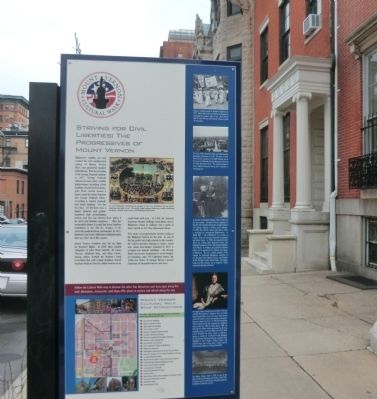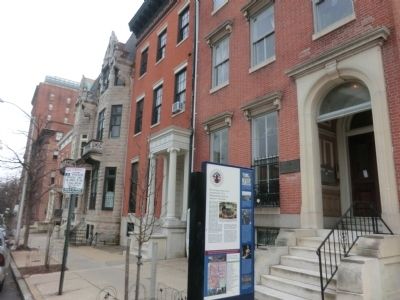Mount Vernon in Baltimore, Maryland — The American Northeast (Mid-Atlantic)
Striving for Civil Liberties: The Progressives of Mount Vernon
Inscription.
Baltimore’s wealthy not only created the rich architectural setting of Mount Vernon Place, but pioneered modern philanthropy. With the founding of the George Peabody Institute in 1857, George Peabody influenced many other wealthy Baltimoreans including Johns Hopkins. On one such occasion, John Work Garrett hosted a dinner party for Johns Hopkins and George Peabody where according to Garrett, Peabody told Johns Hopkins, “For the first time, (I) felt there was a higher pleasure and greater happiness than accumulating money, that was derived from giving it for good and humane purposes…” After this memorable dinner, it is said Johns Hopkins established in his will the creation of the university, medical school, and hospital. By 1893, Baltimore had more millionaire philanthropists than any other city in the country.
Mount Vernon residents also led the fight for Women’s Rights. In 1890, Mary Garrett (daughter of John Work Garrett), M. Carey Thomas, Elizabeth King, and Mary Gwinn, among others, formed the Women’s Fund Committee that, with a large donation, forced Hopkins Medical School to admit women on an equal basis with men. In 1906, the National American Women Suffrage Association met in Baltimore; Susan B. Anthony was a guest of Mary Garrett at 101 West Monument Street.
This strain of progressivism survives today at the Baltimore School for the Arts. As one of the top public arts high schools in the country, the school provides training in dance, visual arts, music and theater. Founded in 1979, it occupies two historic buildings-the Alcazar Hotel, the former headquarters of the Knight of Columbus and 704 Cathedral Street, the 1850s-era home of George Brown, second chairman of Alexander Brown and Sons.
[Captions:]
An 1870 lithograph celebrating the passage of the 15th Amendment giving African Americans the right to vote. The middle image captures Baltimore’s parade celebrating the event. Directly in the center is the Washington Monument.
Women’s suffrage parade in downtown Baltimore in 1913. Many Mount Vernon residents participated in advocating for women’s right to vote. Mary Garrett and M. Carey Thomas held national influenced within the movement.
This view of West Monument Street was taken from the Washington Monument ca. 1903. The home of John Work Garrett, president of the B & O Railroad, sat on the corner of Cathedral and West Monument streets at 101 West Monument Street. The original campus of Johns Hopkins University loomed over rowhouses in the background.
A portrait of Elisabeth Gilman (1867-1950) and her step-mother. Elisabeth Gilman, daughter of the first Johns Hopkins University president Daniel Coit Gilman, became
a tireless social reformer. In 1890, she started a boys’ club and in 1915, a workshop for unemployed Baltimoreans, In World War I, she volunteered as a nurse in France. Here, she become interested in socialism and labor unions. In 1923, she organized relief efforts for striking West Virginian miners and defended members of the International Workers of the World. In addition, she joined the Socialist Party, ran for governor, U.S. Senate, and mayor of Baltimore. She was a board member of the League for Industrial Democracy, secretary of the Maryland Civil Liberties Union, and founder of the Christian Social Justice Fund. Her home, located on Park Avenue, was a refuge for “feisty communist-leaning reformers.”
An image of Mary Elizabeth Garrett (1854-1915) who attended Miss Kramer’s School for Girls, at 8 West Mount Vernon Place. In her early years, Mary Garrett assisted her father in his business activities and became known as “papa’s secretary.” In 1878, she founded the Friday Evening Group that discussed the intellectual issues of the day. After her died in 1884, she inherited two million dollars and began her life-long charitable giving. From the 1880s to the 1910s, Mary Garret founded Bryn Mawr School in Baltimore; became a member of the Board of Lady Managers for the Woman’s Industrial Exchange, donated nearly $400,000 to Johns Hopkins Medical School; and donated large sums to Bryn Mawr College and the North American Women’s Suffrage Association.
The Alcazar Theater, built in 1926 as part of the Alcazar Hotel by the Knights of Columbus. Since 1979, it has been used as a performance and gallery place for the Baltimore School for the Arts.
Erected by Mount Vernon Cultural Walk.
Topics. This historical marker is listed in these topic lists: Charity & Public Work • Patriots & Patriotism. A significant historical year for this entry is 1857.
Location. 39° 17.85′ N, 76° 37.11′ W. Marker is in Baltimore, Maryland. It is in Mount Vernon. Marker is at the intersection of Monument Street and Park Avenue on Monument Street. Touch for map. Marker is at or near this postal address: 202 W Monument St, Baltimore MD 21201, United States of America. Touch for directions.
Other nearby markers. At least 8 other markers are within walking distance of this marker. Maryland Historical Society (a few steps from this marker); Grace and St. Peter's Church (a few steps from this marker); In Full Glory (within shouting distance of this marker); The Enoch Pratt House (within shouting distance of this marker); H. Irvine Keyser (within shouting distance of this marker); On To Yorktown (within shouting distance of this marker); King Gambrinus, 1879 (within shouting distance of this marker); Revival (about 400 feet away, measured in a direct line). Touch for a list and map of all markers in Baltimore.
Credits. This page was last revised on December 12, 2022. It was originally submitted on December 23, 2014, by Don Morfe of Baltimore, Maryland. This page has been viewed 784 times since then and 8 times this year. Photos: 1, 2. submitted on December 23, 2014, by Don Morfe of Baltimore, Maryland. • Bill Pfingsten was the editor who published this page.

